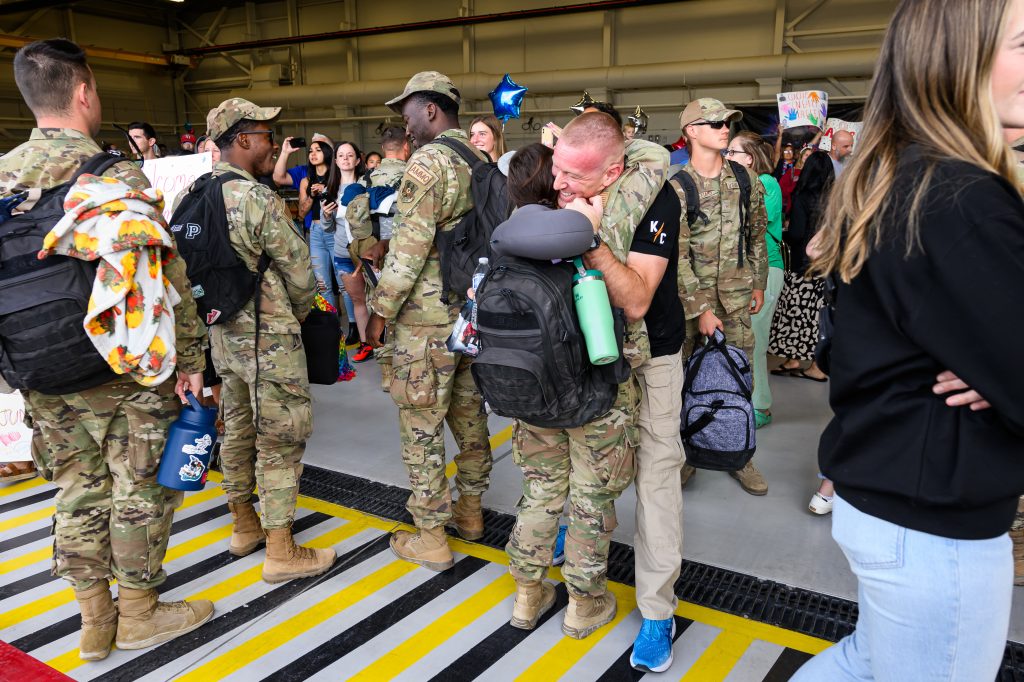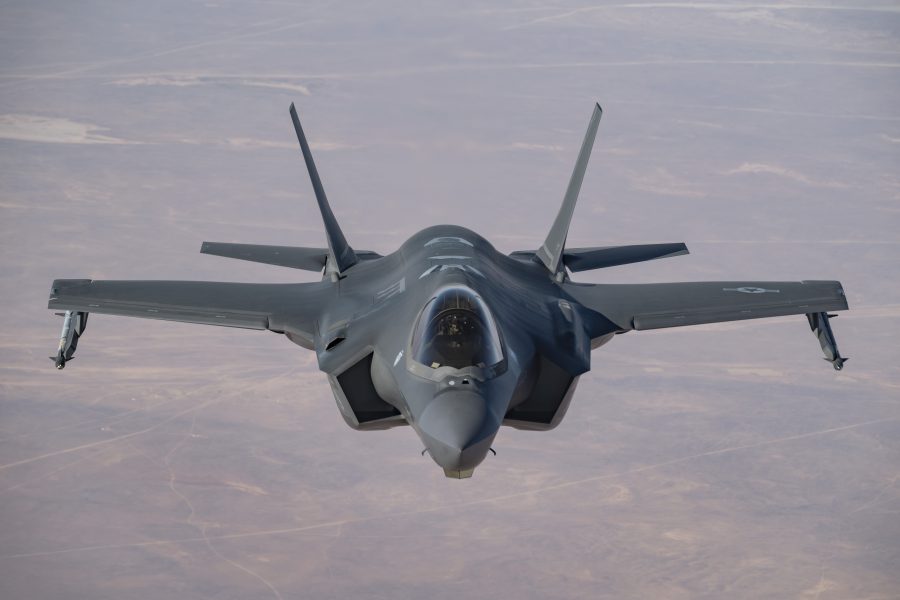Editor’s Note: This article was updated on Oct. 9 following the U.S. response to attacks on Israel.
U.S. Air Force F-35 Lightning II stealth fighters that deployed to the Middle East to deter Iranian aggression in the Persian Gulf and push back against Russian bullying in the skies over Syria have left the region, according to service officials.
“What the F-35s did is they gave us additional capacity,” Air Forces Central (AFCENT) commander Lt. Gen. Alexus G. Grynkewich told reporters Oct. 4 at a Defense Writers Group event.
The deployment wrapped up in late September, according to the 388th Fighter Wing at Hill Air Force Base, Utah. All the aircraft have left the Middle East and are “in transit home,” according to a spokesperson for the 388th Fighter Wing.
Operating as the 421st Air Expeditionary Squadron, the F-35s first deployed July 26, when the fifth-generation fighters were rushed to the region by the Pentagon after Iranian attacks on commercial shipping around the Strait of Hormuz, the strategic chokepoint between the Persian Gulf and the Gulf of Oman through which 20 percent of the world’s oil flows.
Additional U.S. Navy vessels, led by the Bataan Amphibious Ready Group with thousands of Marines, followed the F-35s. The USS Bataan amphibious assault ship brought more airpower into the region with a squadron of vertical or short takeoff and landing (V/STOL) Harriers.
The U.S. still has F-16s and A-10s in the region. However, the stealthy F-35 provided more advanced capabilities.
The F-35s allowed the U.S. to “continue doing the missions we were doing up in Iraq and Syria and elsewhere in the region, and increase what we were doing in support of the Navy doing basically combat air patrols over the Straits of Hormuz,” said Grynkewich, who added the Navy deployment was particularly important.
“That increase in surface vessels combined with our airpower has deterred Iran from taking any actions against maritime shipping,” he said.
In addition to their mission in the Gulf, the F-35s were helpful in discouraging Russian warplanes from harassing American aircraft over Syria. The F-35s also integrated with U.S. allies over Syria, including flying with French Rafael fighters.
Russia’s aggressive tactics emerged as a major concern in July when Russian fighters dropped flares that damaged U.S. MQ-9 drones carrying out missions against Islamic State militants.
After the U.S. released video of the Russian harassment and deployed the F-35s, Russia has moderated its tactics and has become less aggressive.
“They still fly in the airspace, but not directly overhead of our forces, so I welcome that shift in behavior,” Grynkewich said. “The flares being dropped on our MQ-9s, we don’t see that behavior anymore.”
The U.S. military footprint in the region is very modest compared to the years in which Americans were fighting in Iraq and Afghanistan. But U.S. air operations over Syria have also been bolstered by coalition partners, including the French and British.
“We are still under danger of terrorist attack in our capitals or in our land,” Gen. Stéphane Mille, Chief of the French Air and Space Force, told reporters in September. “We are flying together.”
Not all of the challenges the U.S. has faced come from adversaries. America’s fellow NATO member Turkey has been pummeling Kurdish groups in northern Syria it blames for a bombing in the capital of Ankara on Oct. 1, in operations that could put American troops at risk.
On the morning of Oct. 5, a Turkish drone struck targets inside a U.S. military-declared restricting operating zone (ROZ), according to the Pentagon. Strikes got within one kilometer of U.S. forces, forcing them to take cover in bunkers.
When a Turkish drone returned to the area roughly four hours later and headed towards U.S. forces, it was shot down by a U.S. F-16 within half a kilometer of U.S. personnel in an act of self-defense, according to U.S. officials.
On Oct. 6, the Turkish foreign ministry downplayed the episode in a statement, saying its drone “was lost due to different technical assessments in the deconfliction mechanism with third parties.”
The bigger worry, however, remains Iran. Despite the departure of the F-35s, which Grynkewich noted was always planned to be “temporary,” the U.S. is prepared to flex forces to the region.
“My view is that deterrence is temporal,” Grynkewich said of Iran. “We’ve surged forces in response to a specific threat. That shows American commitment to the region. It shows that our American strategy has been, with our posture being less than once was, we’ve shown a commitment to bring forces in for either major exercises for assurance purposes or when a threat required it. And we certainly did that in this case.”
Just days after those comments, the militant group Hamas conducted a surprise attack in Israel on Oct. 7, killing at least 900 people, mostly civilians. In response, Israel’s government declared war against the group, which rules the Gaza Strip, and the Biden administration pledged to provide Israel with military aid.
On Oct. 8, Secretary of Defense Lloyd J. Austin III announced the Pentagon was bolstering the U.S. presence in the region by sending the Gerard R. Ford aircraft carrier and cruise missile-carrying ships to the Eastern Mediterranean. The next day, a senior defense official warned the militant group Hezbollah to “think twice” about opening a northern front against Israel and said the U.S. is in a position to intervene militarily.
“These posture increases were intended to serve as an unequivocal demonstration in deeds and not only in words of U.S. support for Israel’s defense and serve as a deterrent signal to Iran, Lebanese, Hezbollah, and any other proxy across the region who might be considering exploiting the current situation to escalate conflict,” the defense official said.
The Defense Department is also reinforcing the U.S. Air Force’s role in the area.
“We have also taken steps to augment U.S. Air Force F-15, F-16, and A-10 fighter aircraft squadrons in the region,” U.S. Central Command said in statement issued on Oct 8.
Though no F-35s have yet been sent, the Pentagon said such a step might be taken in the future.
“We’re delaying the redeployment of some of our F-35s, so those assets will be among the fighter capabilities available,” Pentagon Press Secretary Brig. Gen. Patrick S. Ryder told Air & Space Forces Magazine on Oct. 8.

